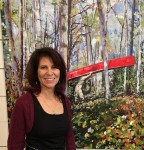Lori Goldberg in front of one of her paintings. (photo from Lori Goldberg)
Lori Goldberg is one of the artists whose work has been chosen to be part of a special project in aid of what will be Abbotsford’s first residential hospice facility, Holmberg House, set to open this year.
“The Reach Gallery and the Abbotsford Arts Council, in partnership with the Abbotsford Hospice Society, selected several artists for the project,” explained Goldberg to the Independent. “After the artworks are completed, the Reach will host an event where donors will bid on them. The proceeds will be split between the Abbotsford Hospice Society, the Reach Gallery and the Abbotsford Arts Council. Some of the works will be placed in Holmberg House. Others will be used to cover medical equipment.”
The artists only receive a small honorarium for their work, which is due at the end of January. But payment comes in other forms. “I like the challenge of creating an uplifting and soulful work that would give the viewer peace and joy,” said Goldberg, who is coming off a fall 2015 solo show at the Zack Gallery called Urban Forest.
The forest theme, intertwined with the “true Canadian” theme, has been filling her canvases for the last several years.
“In the past, my art often involved objects,” Goldberg said. “I was a single mom with two growing sons and I realized recently that the objects and still life in my art meant me being domestic. The objects were all around me, part of my family life, and each object had a story to tell about their owners and the relationships between things and people. An object could be spiritual or mundane, and the stories could change with use.
“But, as my sons grew, I could expand myself. Before, most of my buyers were women. Now, I could reach further with my imagery. I traveled and I taught a lot, and the more I traveled, the more I realized how important my home was: Vancouver, Canada. I started exploring the theme of being Canadian in my art.”
One of the symbols of Canada in Goldberg’s eyes is a canoe. “Visually, the canoe represents something significant. Canoes took explorers across Canada.”
Red canoes float and bob on the water across Goldberg’s paintings. Some of them are big, others small, but all of them are empty. “A canoe is a vessel, and I make it empty on purpose. Everyone looking at my paintings can imagine themselves in the canoe. It is there for them. I did a lot of kayaking in my life, and the experience is similar. You’re on the water, paddling, and there is a landscape unfolding, sometimes peaceful, sometimes dangerous. There is a relationship between the persons in the boats and the landscape. There is a home there.”
For Goldberg, the color of the canoes – red – also represents Canada. “Like on our flag,” she said. “There are people who enjoy boating and water, and they like and buy these paintings. I have some new commissions of the canoes.”
Goldberg loves working on commissions. “I’m good with commissions. People who order them usually know my work, but we always discuss what size of the painting they need, if they want some specific colors, or if they have a story to tell. Maybe they have a cabin on a lake, and then I do research, make lots of sketches, and try to incorporate their familiar landscape details into the painting.”
More often than not, Goldberg’s canoes sail past wild, forested shores, shimmering with green leaves and filtered sunlight. “I like a punch of bright red inside the green,” the artist mused.
Forests, especially Canadian urban forests, have become another important theme in her art. “The forest is so close in Vancouver, just behind your windows. The city is all concrete, but when you step inside a forest, you shed the city, all its artificial neon colors, all the metal and plastic. It all peels off. You become part of nature, but you also become more exposed, more vulnerable, you feel alive. Nature inspires you, but it can also be dangerous, full of beasts and unknown perils. It’s beautiful and uplifting but also powerful. You have to respect it.”
The juxtaposition of the wilderness and the city, our cultural icons among the tangle of branches is a recurring motif in Goldberg’s forests. You could see a deer peeking from behind a tree, or people lugging their suitcases along the woodsy paths. “We all bring our luggage to the forest,” she said. “A forest is as much a metaphor of human lives as it is a real place. There is light and there are shadows there. Our cities are encroaching on the forest, but we need to become caregivers. In my small way, I do what I can, so we can find harmony with nature.”
The theme of urban Canadian forests resonates with many in Canada, and more and more people have become interested in Goldberg’s work. A few months ago, she and her paintings of canoes and forests were profiled in the magazines MontrealHOME, VancouverHOME and TorontoHOME.
More information can be found on the artist’s website, lorigoldberg.ca.
Olga Livshin is a Vancouver freelance writer. She can be reached at olgagodim@gmail.com.

